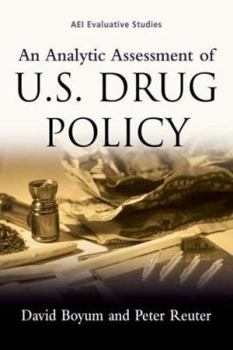An Analytic Assessment of U.S. Drug Policy
In its efforts to control the use of cocaine, heroin, marijuana, and other illegal drugs, the United States spends about $35 billion per year in public funds. Almost half a million dealers and users are under incarceration. In this book, David Boyum and Peter Reuter provide an assessment of how well this massive investment of tax dollars and government authority is working. Boyum and Reuter show that America's drug problem is mainly a legacy of the...
Format:Paperback
Language:English
ISBN:0844741914
ISBN13:9780844741918
Release Date:December 2005
Publisher:AEI Press
Length:133 Pages
Weight:0.50 lbs.
Dimensions:0.6" x 6.0" x 9.0"
Customer Reviews
1 rating
Valuable as primer
Published by Thriftbooks.com User , 18 years ago
Drug prohibition is a smorgasbord of federal policies that are nearly universally declaimed as ineffective at best and harmful at worst. Boyum and Reuter have prepared a masterfully short introduction to this issue. In it they provide a balanced account of the essential information from the history of drug prohibition to a comprehensive overview of the drug problem to a presentation and critique of many of the specific policies that exist. In summary, they show how drug use tends to follow contagion patterns that are often geographically limited rather than widely dispersed growth. Contrary to popular conceptions, dependence and addiction are relatively rare. Prohibition policies heavily favor enforcement and supply restraint; however, the cost effectiveness of these policies seems wanting. Treatment appears substantially more effective. On nearly every page the reader is confronted with a synthesis of the very best evidence available. Some of the more useful information in this slim volume are the critical analyses of federal sources on information on the prevalence of illicit drug use and the budgetary costs associated with the war on drugs. Interestingly, there is little to no research presented on the effectiveness of user sanctions on restraining prevalence, desistence is not really explained, and there is likewise almost no evidence supporting the tremendous resources devoted to prevention programs. Anyone familiar with the debate over drug prohibition will not be surprised by the recommendations contained here. Reduction in criminal sanctions for marijuana use is supported; preference for treatment over penalization is recommended; redirecting enforcement toward the more violent segments of the drug market is suggested; heavier concentration of addicts and dependent users, especially those under mandatory supervision of the criminal justice system is presented as the most likely to negatively impact prevalence. I recommend this volume with one caveat: opposition to the adverse consequences of drug prohibition should not be conflated with opposition to drug prohibition. There is substantial evidence that suggests that reduction in negative consequences for illicit drug users may increase prevalence of use. If this were to occur, what would prevent illicit drugs from becoming as huge a public health problem as alcohol and tobacco currently represent?





